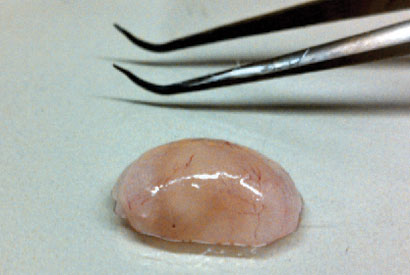UC Berkeley scientists have come up with a way to prompt the growth of “good” energy-burning brown fat in mice, something that in turn helped lower their weight gain and blood sugar levels.
Published in the journal Diabetes, the study says the technique could lead to new approaches to fight obesity and other metabolic disorders. The researchers used a hydrogel scaffold to control an implant containing stem cells to form a functional brown-fat-like tissue. Unlike while white fat which stores excess energy, brown fat is a heat generator and burns calories.
“What is truly exciting about this system is its potential to provide plentiful supplies of brown fat for therapeutic purposes,” said study lead author Kevin Tharp, a Ph.D. student in the Department of Nutritional Sciences and Toxicology. “The implant is made from the stem cells that reside in white fat, which could be made from tissue obtained through liposuction.”
Human babies have greater stores of brown fat, so-called because it contains high levels of darker-hued mitochondria. It was once believed that brown fat disappears with age, but in recent years, this tissue has been discovered in the neck, shoulders, and spinal cord among adults.
“This is figuratively and literally a hot area of research right now,” said the study’s senior author, Andreas Stahl, an associate professor of nutritional sciences and toxicology. “We are the first to implant in mice an artificial brown-fat depot and show that it has the expected effects on body temperature and beneficial effects on metabolism.”
Studies have shown that cold temperatures can bump up activity in brown fat. Stahl noted, however, that the exposure to cold often led to increases in food intake, as well, potentially negating any calorie-burning benefits from brown-fat activity.
Get the fat, not the cold
There are three basic types of fat tissue in our bodies. There is the classic, energy-storing white fat that many of us are most familiar with, and two kinds of energy-burning fat used to generate heat, namely brown fat, which arises during fetal development, and beige fat, which is brown-like fat formed within white fat tissue after exposure to cold and other situations.
This UC Berkeley experiment explored the idea of increasing brown-like beige fat without the temperature drop. Stahl teamed up with Kevin Healy, UC Berkeley professor of bioengineering, and postdoctoral researcher Amit Jha to develop a system of physical cues to guide stem cell differentiation.
“It’s already known that for a number of organs, including the heart, the extracellular matrix in which a cell resides provides signals to guide growth and development,” said Healy, who also has an appointment in the Department of Materials Science and Engineering. “We applied this concept to stem cells isolated from white-fat tissue.”
The specific matrix recipe for converting white-fat stem cells to brown fat had been unclear, the researchers said, but they noted that previous studies suggested that stiffness of the surrounding environment was a factor. White-fat stem cells placed in a 3D environment that is soft, with little resistance as the cell grows, became fat. When the surrounding environment was very stiff, the stem cells grew into bone.
Injected brown fat reduces weight gain, glucose
The researchers created a tightly knit 3D mesh in a hydrogel containing water, hyaluronic acid and short protein sequences associated with brown-fat growth and function. Hyaluronic acid is a naturally occurring carbohydrate that helps make water thicker and gel-like. They then took white-fat stem cells from mice genetically engineered to express an enzyme from fireflies. This made the cells luminescent, allowing the researchers to track them more easily.
The researchers then added the cells to the hydrogel and, before the mixture thickened, injected them under the skin of genetically identical mice.
The gel polymerizes after injection and completes its transformation in the animal. The researchers monitored the glowing cells after injection to determine how well they stayed put, how long they persisted in the body and whether they were metabolically functional.
They noticed an increase in the core body temperature of the mice at ambient temperatures of 21 degrees Celsius and after 24 hours at a chilly 4 degrees Celsius. In both cases, the mice with the implanted cells were up to half a degree Celsius warmer than a control group of mice with no injection. The higher the concentration of cells, the larger the effect on temperature.
The researchers also put the experimental mice on a high-fat diet. By the end of three weeks, the mice with injected beige fat gained half as much weight and had lower levels of blood glucose and circulating fatty acids compared with control mice.
“This is a feasibility study, but the results were very encouraging,” said Stahl. “It is the first time an optimized 3D environment has been created to stimulate the growth of brown-like fat. Given the negative health effects of obesity, research into the role of brown fat should continue to see if these findings would be effective in humans.” The National Institutes of Health and the American Diabetes Association helped fund this research.
If our reporting has informed or inspired you, please consider making a donation. Every contribution, no matter the size, empowers us to continue delivering accurate, engaging, and trustworthy science and medical news. Independent journalism requires time, effort, and resources—your support ensures we can keep uncovering the stories that matter most to you.
Join us in making knowledge accessible and impactful. Thank you for standing with us!

